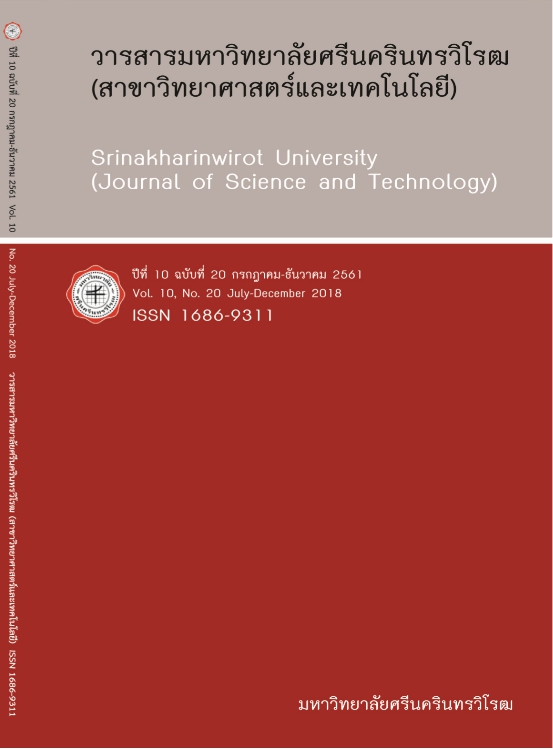การศึกษาความสัมพันธ์ของโครงสร้างร่างกายและโครงสร้างกะโหลกศีรษะและใบหน้า THE RELATIONSHIP BETWEEN BODY STRUCTURE AND FACIAL STRUCTURE
Keywords:
Orthodontic Treatment, Craniofacial Structure, Body Structure, ForceplateAbstract
Introduction: At present, orthodontic treatment is able to improve the facial profile by correcting the abnormality of the hard tissue. But it was found that the most common problem after the treatment is the relapse of dental misalignment. It has been claimed that people who have abnormality in facial structure will have abnormality in the body structure as well. So correcting only the facial structure cannot maintain the condition and it may contribute to the relapse. So this study found out about the correlation between the body structure examined by clinical examination and craniofacial structure.
Material and Method: 34 healthy subjects, who never experienced orthodontic treatment, body structure alteration procedure or had serious accident which affected the body structure, were captured their facial photographs by Canon 450D with Micro Lens in the position and analyzed with AutoCAD for Mac 2012 program. The facial structures were evaluated by measuring the deviation of menton from facial midline and the angle between interpupillary line and tongue blade which resemble the occlusal plane. Forceplate were selected to examine the body balance and the result of the center of pressure was shown. Subjects were asked to stay still on forceplate in the position for 30 seconds each time, twice. Scoliometer was used to analyze the body structure by measuring at thoracic and lumbar spine levels as per the standard instruction of the device. Data from each subject was analyzed by Linear Regression.
Result: The symmetry of lumbar spine structure is significantly directly related to the deviation of menton from facial midline and to the angle between interpupillary line and occlusal plan (p-value =.05).
Conclusion: The result from this study shows that the body posture and craniofacial structure is correlated. So the basic method for body posture evaluation by forward bend test can be used to screen the malocclusion patient before orthodontic treatment.
Downloads
References
[2] Shimazaki T, Motoyoshi M, Hosoi K.; and Namura S. (2003). The effect of occlusal alteration and masticatory imbalance on the cervical spine. Eur J Orthod. 25: 457-463.
[3] Gangloff P, Louis JP; and Perrin PP. (2000). Dental occlusion modifies gaze and posture stabilization in human subjects. Neurosci Lett. 293: 203-206.
[4] Broadbent Sr BH, Broadbent Jr BH; and William HG. (1975). Bolton standards of dentofacial developmental growth. St.Louis: The C.V. Mosby Company.
[5] Bracco P, Deregibus A; and Piscetta R. (2004). Effects of different jaw relations on postural stability in human subjects. Neurosci Lett. 356: 228-230.
[6] Sforza C, Tartaglia GM, Solimene U, Morgun V, Kaspranskiy RR; and Ferrario VF. (2006). Occlusion, sternocleidomastoid muscle activity and body sway: a pilot study in male astronauts. Cranio. 24: 43-49.
[7] Perinetti G, Contardo L, Biasati AS, Perdoni L; and Castaldo A. (2010). Dental malocclusion and body posture in young subjects: A multiple regression study. Clinics (Sao Paulo). 65(7): 689-695.
[8] Perinetti G. (2006). Dental occlusion and body posture: no detectable correlation. Gait & Posture. 24(2): 165-168.
[9] Haraguchi S, Iguchi Y; and Takada K. (2008). Asymmetry of the face in orthodontic patients. Angle Orthod. 78: 421-426.
[10] Ercan I, Ozdemir ST, Etoz A, Sigirli D, Tubbs RS, Loukas M; and Guney I. (2008). Facial asymmetry in young healthy subjects evaluated by statistical shape analysis. J Anat. 213: 663-669.
[11] Bishara SE, Burkey PS; and Kharouf JG. (1994). Dental and facial asymmetries: a review. Angle Orthod. 64: 89-98.
[12] Padwa BL, Kaiser MO; and Kaban LB. (1997). Occlusal cant in the frontal plane as a reflection of facial asymmetry. J Oral Maxillofac Surg. 55: 811-817.
[13] Haraguchi S, Takada K; and Yasuda Y. (2002). Facial asymmetry in patients with skeletal Class III deformity. Angle Orthod. 72: 28-35.
[14] Amendt LE, Ause-Ellias KL, Eybers JL, Wadsworth CT, Nielsen DH; and Weinstein SL. (1990). Validity and reliability testing of the Scoliometer. Phys Ther. 70(2): 108-117.
[15] Winter DA. (1995). Human balance and posture control during standing and walking. Gait & Posture. 3: 193-214.
[16] Duarte M; and Freitas SM. (2010). Revision of posturography based on force plate for balance evaluation. Rev Bras Fisioter. 14(3): 183-192.
[17] Kleckers T. (2012). Force sensors based on strain gages and piezoelectric crystal-based force transducers in mechatronic systems - A comparison. in Instrumentation and Measurement Technology Conference (I2MTC). 2306-2308.
[18] Shimazaki T, Motoyoshi M, Hosoi K; and Namura S. (2003). The effect of occlusal alteration and masticatory imbalance on the cervical spine. Eur J Orthod. 25: 457-463.
[19] Bracco P, Deregibus A; and Piscetta R. (2004). Effects of different jaw relations on postural stability in human subjects. Neurosci Lett. 356: 228-230.
[20] Kapteyn TS, Bles W, Njiokiktjien CJ, Kodde L, Massen CH; and Mol JM. (1983). Standardization in platform stabilometry being a Part of sosturography. Agressologie. 24: 321-326.
[21] Mcllroy WE; and Maki BE. (1997). Preferred placement of the feet during quiet stance: development of a standardized foot placement for balance testing. Clin Biomech. 12: 66-70.
[22] Levinkind M. (2008). Consideration of whole body posture in relation to dental development and treatment of malocclusion in children. BDA Journal Supplement: 1-6.
Downloads
Published
How to Cite
Issue
Section
License
Srinakharinwirot University Journal of Sciences and Technology is licensed Under a Creative Commons Attribution-NonCommercial-NoDerivs 4.0 International (CC-BY-NC-ND 4.0) License, Unless Otherwise Stated. Please Read Journal Policies Page for More Information on Open Access, Copyright and Permissions.



